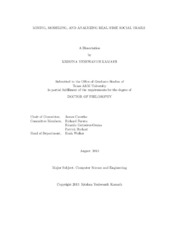| dc.description.abstract | Real-time social systems are the fastest growing phenomena on the web, enabling millions of users to generate, share, and consume content on a massive scale. These systems are manifestations of a larger trend toward the global sharing of the real-time interests, affiliations, and activities of everyday users and demand new computational approaches for monitoring, analyzing, and distilling information from the prospective web of real-time content.
In this dissertation research, we focus on the real-time social trails that reflect the digital footprints of crowds of real-time web users in response to real-world events or online phenomena. These digital footprints correspond to the artifacts strewn across the real-time web like posting of messages to Twitter or Facebook; the creation, sharing, and viewing of videos on websites like YouTube; and so on. While access to social trails could benefit many domains there is a significant research gap toward discovering, modeling, and leveraging these social trails. Hence, this dissertation research makes three contributions:
• The first contribution of this dissertation research is a suite of efficient techniques for discovering non-trivial social trails from large-scale real-time social systems. We first develop a communication-based method using temporal graphs for discovering social trails on a stream of conversations from social messaging systems like instant messages, emails, Twitter directed or @ messages, SMS, etc. and then develop a content-based method using locality sensitive hashing for discovering content based social trails on a stream of text messages like Tweet stream, stream of Facebook messages, YouTube comments, etc.
• The second contribution of this dissertation research is a framework for modeling and predicting the spatio-temporal dynamics of social trails. In particular, we develop a probabilistic model that synthesizes two conflicting hypotheses about the nature of online information spread: (i) the spatial influence model, which asserts that social trails propagates to locations that are close by; and (ii) the community affinity influence model, which asserts that social trail prop- agates between locations that are culturally connected, even if they are distant.
• The third contribution of this dissertation research is a set of methods for social trail analytics and leveraging social trails for prognostic applications like real-time content recommendation, personalized advertising, and so on. We first analyze geo-spatial social trails of hashtags from Twitter, investigate their spatio-temporal dynamics and then use this analysis to develop a framework for recommending hashtags. Finally, we address the challenge of classifying social trails efficiently on real-time social systems. | en |



